 Sunday/Weekend
Sunday/Weekend

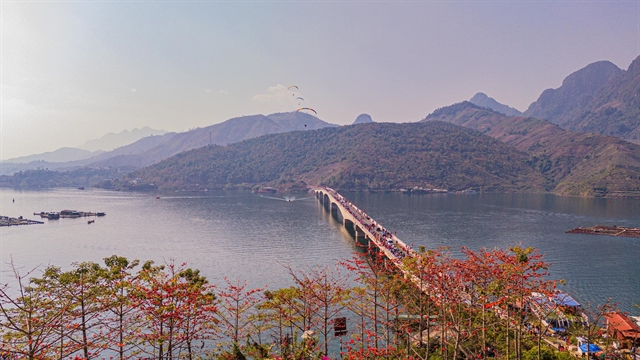 |
| Kapok trees in blossom next to Sơn La hydroelectric reservoir. — Photo laodong.vn |
By Thanh Nga
We were fortunate to visit Mường La, the mountainous district of Sơn La Province in the northwest, during a vibrant spring, when the mountains and forests were adorned with the blossoms of sơn tra, also known as assam apple.
This journey filled us with excitement as we discovered a region blessed with breathtaking landscapes and rich historical and cultural treasures.
Mường La lies some 40km northeast of central Sơn La City, and 300km northwest of Hà Nội. With its predominantly mountainous terrain at an average altitude of 500-700m above sea level, Mường La offers a diverse range of natural wonders that promise to captivate every visitor.
As we ventured into the eastern and northeastern parts of the district, we marvelled at the majestic mountains that gradually gave way to lower terrain in the southern region and along the banks of the Đà River. This geographical diversity, coupled with the presence of the Đà and several large streams, creates a captivating landscape that has earned Mường La the reputation of being the hub of Sơn La tourism.
In addition, the cool climate of the northwest region adds to the allure, making it an ideal destination throughout the year.
Making the most of its stunning natural beauty and unique cultural identity, Mường La has focused on developing various forms of tourism, including cultural tourism, ecotourism, community-based tourism, and the exploration of archaeological relics.
“The district's tourism potential is accentuated by notable features such as the Sơn La hydroelectric power plant. Mường La boasts over 10 hot mineral water areas that draw in numerous tourists seeking relaxation and rejuvenation," Nguyễn Văn Tâm, vice chairman of Mường La District People's Committee [district government] told Việt Nam News.
"The district's lush forests, covering an area of over 60,000ha, offer an excellent opportunity for nature enthusiasts. Ngọc Chiến Commune, in particular, boasts a remarkable natural forest area of over 85 per cent, equivalent to 18,000ha, making it an ideal tourist destination.”
While the Sơn La hydroelectric plant stands as a prominent attraction, it is just one among a collection of more than 10 large and small hydroelectric projects featuring artificial lakes on rivers and streams such as Nặm Mu, Nặm Chiến and Nặm Trai.
The Sơn La hydroelectric plant, located in Ít Ong Commune approximately 40km from the city centre, was completed in seven years, becoming one of the largest hydroelectric plants in Việt Nam and Southeast Asia.
Taking advantage of the expansive water surface of the plant's reservoir, Mường La has embraced the development of experiential tourism, offering visitors the opportunity to embark on sightseeing cruises, visit fish-rearing rafts on the lake, indulge in kayaking adventures, and savour the local cuisine and experience ethnic culture in the charming lakeside communities of Mường Trai, Hua Trai and Chiềng Lao.
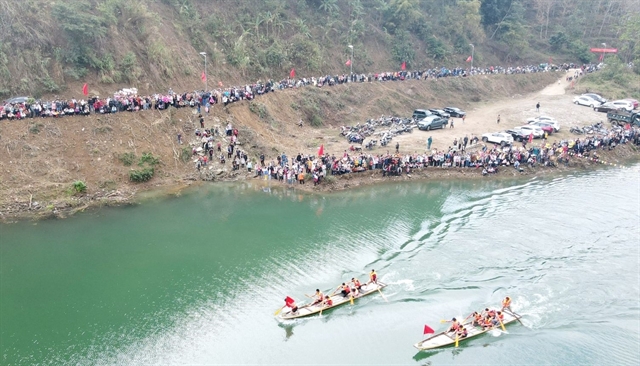 |
| The boat racing festival in Tạ Bú Commune, Mường La District attracts a large number of tourists and people in the area. — Photo baosonla.org.vn |
Mường La is indeed a treasure trove of natural wonders and cultural heritage. Apart from the hot mineral water springs in Hua Ít Village, Lướt Village and Nà Cưa Village, the district is also blessed with limestone cave systems and archaeological sites that offer a glimpse into its rich history.
Co Noong Cave, located in Ít Ong Town, is an archaeological site that leaves visitors awe-struck with its enchanting beauty. The cave is adorned with numerous multicoloured metallic stalactites and intriguing formations, creating a magical ambience.
The view from the cave entrance is breathtaking, allowing visitors to observe the Sơn La hydroelectric project, Ít Ong Town, the Phiêng Tìn rubber plantation, the Mường La bridge, and the entire downstream area of the Đà.
Meanwhile, Ngọc Chiến Commune, situated at an elevation of 1,600 to 1,800m above sea level, is renowned for its scenic view of assam apple trees in blossom. The commune boasts pristine mountain landscapes and a cool climate that remains refreshing throughout the year.
Exploring Ngọc Chiến provides an opportunity to immerse oneself in the unique and diverse cultures of the Mông and Thái ethnic minorities, who inhabit picturesque villages. The fairytale countryside, with its houses on stilts featuring hundred-year-old wood roofs and natural hot mineral springs, offers visitors enchanting experiences.
“The hot springs in Ngọc Chiến are believed to offer various health benefits, such as alleviating skin diseases, rheumatism, cardiovascular ailments, and reducing stress. I find solace and relaxation in soaking in the thermal water after busy and stressful days,” said visitor Nguyễn Thị Diệp from Hà Nội.
According to Bùi Tiến Sỹ, the secretary of the communist party committee of Ngọc Chiến, the commune has focused on developing various forms of tourism, including ecotourism, spiritual tourism, historical-cultural heritage tourism, and resort tourism. The commune has prioritised the development of infrastructure and aims to create a unique tourism chain that fosters cohesion between different localities, with the ultimate goal of sustainable tourism development.
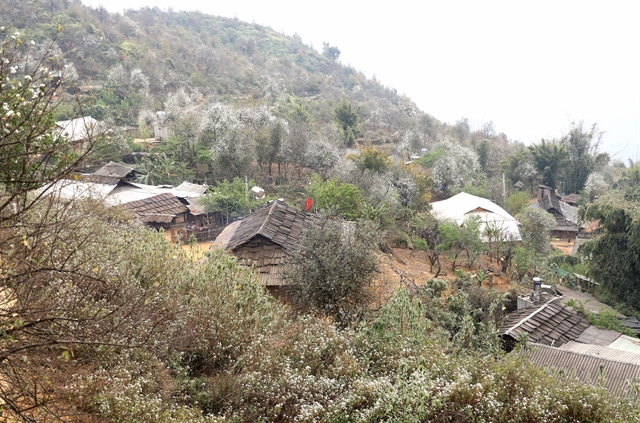 |
| Assam apple flowers bloom in Nậm Nghẹp Commune. — VNS Photo Đoàn Tùng |
Another destination not to be missed is Cát Lình Village in Chiềng Muôn Commune, home to the Mông ethnics who possess distinct cultural features.
The village, situated atop Pu Tha Kềnh Mountain at an altitude of over 2,500m, is proud to have a landscape characterised by majestic mountains, lush forests, and terraced fields that stretch out in layers. This untamed environment is a haven for diverse wildlife, including monkeys, and is adorned with primaeval forests and abundant water streams that flow throughout the year.
Mường La District takes pride in preserving and celebrating its traditional cultural heritage through various festivals such as Xên Bản, Xên Mường, Pang A, and the new harvest celebration festival.
Traditional dances and folk games like stick pushing and cloth ball throwing are also cherished. The culinary culture of the region showcases the distinct flavours of the northwest mountains and forests, with dishes like grilled sticky rice, stir-fried bamboo shoots, grilled stream fish, black boned chicken, and wild vegetable salads.
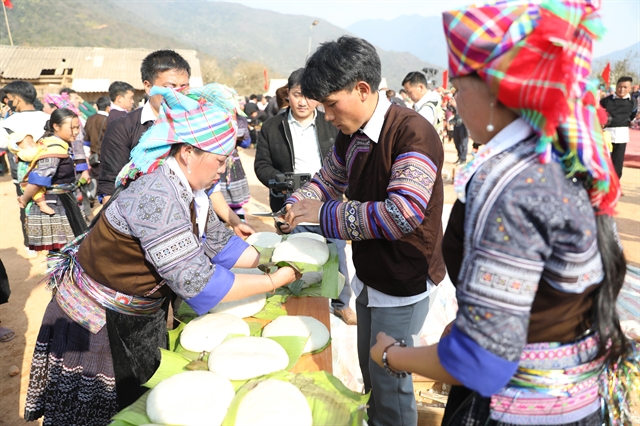 |
| People enjoy bánh dày (round rice cake) during the assam apple flower festival in Nậm Nghẹp Commune. — VNS Photo Đoàn Tùng |
These cultural treasures serve as an advantage for Mường La in attracting investments in tourism services. Building upon its potential, the district has formed and developed a tourism and service economic triangle consisting of Ít Ong Town, Ngọc Chiến Commune, and Chiềng Lao Commune. Each locality offers unique features and specific tourist attractions.
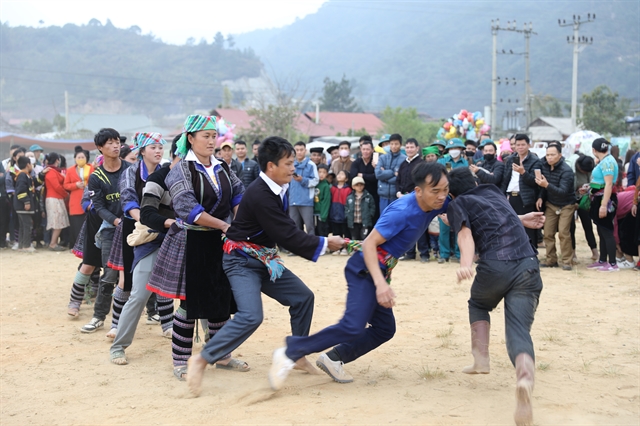 |
| Locals play a folk game in Mường La. — VNS Photo Đoàn Tùng |
Ít Ong Town serves as the economic and cultural centre of the district, housing the Sơn La hydroelectric plant, historical relics of Pom Pát station, archaeological relics of Co Noong Cave, and hot water springs.
Ngọc Chiến Commune, with its fresh and cool climate, hot mineral springs, and assam apple flower festival, provides a distinct charm.
Chiềng Lao Commune, located about 25km northwest of Ít Ong Town, offers a huge lakeside area, the Huổi Quảng hydroelectric plant, and Mt Khau Ưng, making it ideal for ecotourism and fishing.
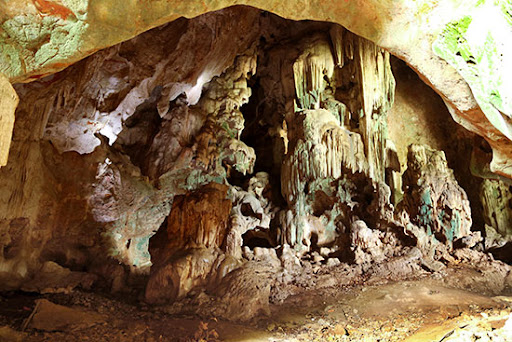 |
| Co Noong Cave, located in Ít Ong Town, is an archaeological site that leaves visitors awe-struck with its enchanting beauty. — Photo sonla.gov.vn |
To tap into its potential, Mường La District has launched a tourism development project for 2020-2025. Over the years, tours and tourist routes have been established, accommodation facilities have been developed and local cultural heritage and natural landscapes have been explored for tourism.
These efforts have attracted a significant number of domestic and international tourists to the district. Several businesses have also shown interest in researching and developing investment plans in Mường La tourism business, thereby creating jobs for the locals.
 |
| Tourists check in at Tà Chì Nhù mountain peak in Yên Bái Province. They often start their journey from Nậm Nghẹp Village, Mường La District, Sơn La Province. In this itinerary, they will have wonderful experiences when exploring Tà Chì Nhù peak. — Photo baosonla.org.vn |
Since last year the district has welcomed about 140,000 visitors, generating a total revenue of nearly US$2 million from tourism.
To ensure sustainable tourism development, Mường La District is strengthening investment cooperation in infrastructure development and creating regional connections with neighbouring districts in Sơn La and Yên Bái provinces. These efforts aim to highlight the natural beauty, ethnic culture, and tourism potential of these northwestern districts. VNS